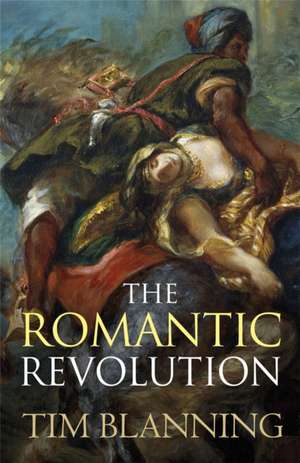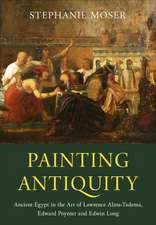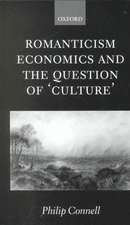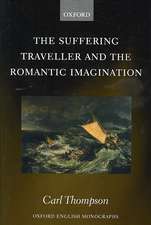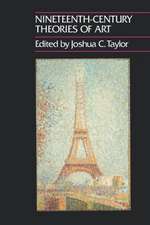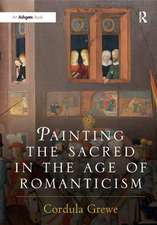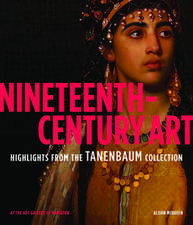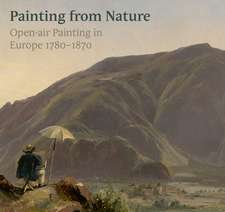The Romantic Revolution
Autor Tim Blanningen Limba Engleză Paperback – 27 oct 2011
| Toate formatele și edițiile | Preț | Express |
|---|---|---|
| Paperback (2) | 48.95 lei 3-5 săpt. | +25.14 lei 7-13 zile |
| Orion Publishing Group – 27 oct 2011 | 48.95 lei 3-5 săpt. | +25.14 lei 7-13 zile |
| Modern Library – 13 aug 2012 | 115.75 lei 3-5 săpt. |
Preț: 48.95 lei
Preț vechi: 63.83 lei
-23% Nou
Puncte Express: 73
Preț estimativ în valută:
9.37€ • 9.66$ • 7.91£
9.37€ • 9.66$ • 7.91£
Carte disponibilă
Livrare economică 08-22 februarie
Livrare express 25-31 ianuarie pentru 35.13 lei
Preluare comenzi: 021 569.72.76
Specificații
ISBN-13: 9780753828656
ISBN-10: 0753828650
Pagini: 256
Ilustrații: Illustrations
Dimensiuni: 128 x 196 x 24 mm
Greutate: 0.25 kg
Editura: Orion Publishing Group
ISBN-10: 0753828650
Pagini: 256
Ilustrații: Illustrations
Dimensiuni: 128 x 196 x 24 mm
Greutate: 0.25 kg
Editura: Orion Publishing Group
Notă biografică
Tim Blanning is an award-winning editor and the author of The Culture of Power and the Power of Culture, which won a prestigious German prize and was short-listed for the British Academy Book Prize, The Pursuit of Glory, and The Triumph of Music. In 2000 he was awarded a Pilkington Prize for teaching by the University of Cambridge.
Extras
Chapter 1
The Crisis of the
Age of Reason
Rousseau on the Road to Vincennes
On June 28, 1751, the first volume of the Encyclopedia, or a systematic dictionary of the sciences, arts, and crafts (better known in its abbreviated French form as the Encyclopédie), edited by Jean le Rond d'Alembert and Denis Diderot, was published in Paris. Originally intended to be nothing more than a translation of Ephraim Chambers's Cyclopædia of 1728, the project soon expanded to ten volumes and kept on growing. By the time it reached completion with a two-volume index in 1780 it covered thirty-five volumes containing more than twenty million words. This was much more than a reference work: It was underpinned by a mission to modernize. Once all knowledge had been assembled and its fundamental principles identified, the way would be clear for further progress. It was a process that necessarily involved casting a critical eye at existing institutions, customs, and values. As Diderot put it in his article on Encyclopedia: "All things must be examined, debated, investigated without exception and without regard for anyone's feelings. . . . We must ride roughshod over all these ancient puerilities, overturn the barriers that reason never erected, and give back to the arts and the sciences the liberty that is so precious to them." Although the sharp eye of the censor compelled discretion, chief among those "ancient puerilities" that Diderot had his eye on was the Catholic Church.
The impact of the Encyclopédie was immediate and lasting. An instant bestseller right across Europe, it had sold more than twenty-five thousand complete sets by 1789, more than half of them outside France. Anyone who contributed to it automatically became a celebrity: "In the past," wrote Voltaire, "men of letters were not admitted into polite society, they have now become a necessary part of it." Fierce opposition from the conservative press and intermittent persecution by the authorities, culminating in an outright ban by both king and pope in 1759, helped to promote a sense of solidarity among both contributors and sympathizers, so that encyclopédiste entered the language to denote a progressive intellectual. But by the time they were forced underground, Diderot and d'Alembert had succeeded in their mission of creating an institutional center for their project of Enlightenment. Also in 1759 d'Alembert claimed in his treatise Elements of Philosophy: "A most remarkable change has taken place in our ideas, a change which by its rapidity, seems to promise us a greater one yet. . . . Our century has called itself supremely the century of philosophy."
This triumphalism derived in part from the knowledge that the Encyclopédie was only one of many major works of enlightened philosophy to have been published around the middle of the century, including Montesquieu's The Spirit of the Laws in 1748, the first volume of Buffon's Natural History in 1749, Condillac's Treatise on Systems, also in 1749, and Voltaire's The Age of Louis XIV in 1751. Yet at the very moment that the tide seemed to be running irresistibly in their favor, a mighty splash announced the appearance of an intrepid opponent determined to swim against the current. This was Jean-Jacques Rousseau, who in July 1749 had a conversion experience while on his way to see his friend Diderot in prison at Vincennes, just outside Paris. Unable to afford a carriage, Rousseau went on foot, whiling away the time by reading the Mercure de France. His eye was struck by an advertisement for a prize essay competition staged by the Academy of Dijon. The topic was: "Has the progress of the sciences and arts done more to corrupt morals or improve them?" In his autobiography Confessions, published posthumously in 1782, Rousseau recalled: "The moment I read this I beheld another universe and became another man." In another account he went into more detail about the extreme nature of his reaction: "I felt my mind dazzled by a thousand lights. . . . I felt my head seized by a dizziness that resembled intoxication." Slumping to the ground, he spent the next hour in a kind of trance, sobbing so passionately that when he came to his senses he found his coat drenched with tears.
The reason for this effusion was Rousseau's sudden insight that the Dijon Academy's question was not rhetorical. Collecting his wits, he set about articulating his epiphany in A Discourse on the Moral Effects of the Arts and Sciences, which won the prize and was published the following year. With all the zeal of the convert, he proclaimed that, contrary to expectation, the civilizing process was leading not to liberation but to enslavement, as it has flung "garlands of flowers over the chains which weigh us down," so that "our minds have been corrupted in proportion as the arts and sciences have improved." All the various branches of the natural sciences, he observed, have their origins in a vice: astronomy in superstition, mathematics in greed, mechanics in ambition, physics in idle curiosity. Even printing had proved to be a false friend, for it had allowed the dissemination of impious tracts, such as those of Hobbes and Spinoza. Rousseau ended his diatribe with the prediction that eventually men would become so alienated from the modern world that they would beg God to give them back their "ignorance, innocence, and poverty, the only goods that can make for our happiness and that are precious in your sight."
This was to turn the agenda of the Enlightenment on its head with a vengeance. Throwing caution to the winds, Rousseau went out of his way to distance himself from his former friends, accusing them of subverting the traditional values of patriotism and religion in pursuit of "the destruction and degradation of everything sacred among men." It took a long time for the philosophes to realize just how extreme was Rousseau's apostasy. They chose to see his Discourse as "a paradox rather than a conviction." Complacently believing that history was on their side, they moved from bewilderment to irritation to hostility, even hatred in the case of Diderot or Voltaire. Yet although they might dismiss him as a "lunatic," as Voltaire did, they could not help but notice that Rousseau's antimodernism had struck a responsive chord in many readers. What made him more dangerous was his total lack of any connection with the establishment. On the contrary, he had proved his credentials as a sea green incorruptible by ostentatiously turning his back on the offer of a royal pension in 1752. His rejection of the Enlightenment had made him more radical.
Rousseau's Lovers: From a Mimetic to an Expressive Aesthetic
Even the least perceptive of the philosophes had to wake up to the threat when in 1761 Rousseau published an epistolary novel. The title of the very first edition was Letters from two lovers living in a small town at the foot of the Alps, but it soon became known as Julie, or The New Héloïse. Voltaire's reaction that he would rather kill himself than read such "a stupid, bourgeois, impudent and boring" book all the way through was not shared by the European reading public. By the end of the century it had gone through more than seventy editions, becoming the biggest bestseller of the century in the process. When the printing presses proved unable to keep up with demand, enterprising Parisian booksellers resorted to renting out copies by the day or even hour. Rousseau was already famous: La Nouvelle Héloïse turned him into a cult. The fan mail that poured in-and which he carefully preserved-was remarkable as much for its intensity as for its bulk. Typical was an effusion from the cavalry captain Jean-Louis Le Cointe, which began with the apologetic exclamation: "Yet another letter from someone unknown to you!" Yet, he went on, so full was his heart that he had to overcome his reluctance to disturb the most amiable philosopher of all time. Not only had Rousseau's book made a case for morality more effectively than any sermon, he wrote, it had also shown men how they could achieve earthly happiness.
By pretending to be only the editor of a collection of letters he had stumbled on, Rousseau sought to give the novel the kind of immediacy achieved today by the better television soap operas. His success with only the written word at his disposal says a great deal for his literary skills, for he was required to assume the guise of several different characters-Julie, the long-suffering and ultimately doomed heroine; her lover, the sensitive Saint-Preux; Lord Edward Bomston, an English nobleman as warmhearted as he is rich; Wolmar, the noble atheist; and so on. Many of Rousseau's correspondents took him at his word, insisting that the events depicted had really happened and demanding to know what had happened after the end of the book. Not at all untypical was the Marquise de Polignac's anguished letter describing her reaction to Julie's death: "I dare not tell you the effect it made on me. My heart was crushed. Julie dying was no longer an unknown person. I believed I was her sister, her Claire. My seizure became so strong that if I had not put the book away I would have been as ill as those who attended that virtuous woman in her last moments."
This was not the first time that the tear ducts of eighteenth-century readers had opened their floodgates. The sentimental novels of Samuel Richardson, for example, had achieved a similar response in the 1740s. What raised Rousseau's emotional appeal above the ruck was its autobiographical dimension. As he himself observed:
What won me the women's favour was their belief that I had written my own story and that I was myself the hero of my novel. The belief was so firmly established that Mme de Polignac wrote to Mme de Verdelin, begging her to persuade me to let her see Julie's portrait. Everybody was convinced that it was impossible to express feelings so vividly unless one had felt them, or so to depict the raptures of love except with one's own heart as model. In that they were right, and it
is true that I wrote the novel in a state of burning
ecstasy.
This passage is from Rousseau's Confessions, which begins with a programmatic declaration of the primacy of the individual. The opening words are: "I have resolved on an enterprise which has no precedent, and which, once complete, will have no imitator. My purpose is to display to my kind a portrait in every way true to nature, and the man I shall portray will be myself. Simply myself. I know my own heart and understand my fellow man. But I am made unlike any one I have ever met; I will even venture to say that I am like no one in the whole world. I may be no better, but at least I am different."
This signaled nothing less than a revolution, one that placed the creator, not the created, at the center of aesthetic activity. The mimetic view it overturned dated back at least to Plato, who expounded it in Book Ten of The Republic through Socrates in conversation with Glaucon, using an everyday object such as a couch as illustration: "We have these three sorts of couch. There's the one which exists in the natural order of things. This one, I imagine we'd say, was the work of a god. . . . Then there's the one made by the carpenter. . . . And then there's the one made by the painter. . . . Painter, carpenter, god. Three agents responsible for three kinds of couch." So the painter, poet, or any other kind of artist is twice removed from the ideal couch, that is to say from the truth. Plato also provided a simile to aid understanding of what the artist did, likening him to a man who carried a mirror around with him and was thus able to imitate the external world and all that lived in it.
Subsequent theorists may not have shared Plato's disdain for the arts and those who practiced them, but they adhered to the central concept of imitation. Representative of the mainstream of the age of the Enlightenment was Abbé Dubos, hailed by Voltaire in The Age of Louis XIV as "a man of great judgment." In Critical Reflections on Poetry and Painting, first published in 1719 but still being reprinted in the 1750s, he wrote: "Just as a painting imitates the features and colours of nature, so does the musician imitate the sounds, accents, sighs and inflexions of the human voice, together with all the sounds with which nature expresses its feelings and passions." Imitation did not mean mere copying, of course. Nor did it mean the mechanical reproduction of a specific object. Rather it involved seeking the best elements of nature at its finest (la belle nature) and reproducing them in a painting, sculpture, poem, piece of music, or whatever. By selecting and combining natural elements containing beauty, the artist could produce an idealized image more beautiful than nature itself could ever supply. This quest could be assisted by a study of classical Greece and Rome, for it was there that the best examples of idealized beauty could be found, thanks to the superiority of their climate and culture. Hence Winckelmann's famous injunction in his seminal treatise On the Imitation of the Painting and Sculpture of the Greeks of 1755: "There is but one way for the moderns to become great, and perhaps unequalled; I mean by imitating the ancients."
For neoclassicists such as Winckelmann, the manifest superiority of buildings such as the Parthenon, or statues such as the Apollo Belvedere, revealed the existence of rules governing artistic creation. Moreover, they were rules that could be taught-rules that should be taught. In drama there were unities of time and place to be observed; in the visual arts there were the classical proportions to be observed. As Sir Joshua Reynolds put it in 1769: "I would chiefly recommend, that an implicit obedience to the Rules of Art, as established by the practice of the great Masters, should be exacted from the young Students. That those models, which have passed through the approbation of ages, should be considered by them as perfect and infallible guides; as subjects for their imitation, not their criticism." This trenchant advice was delivered in his first discourse to the recently created Royal Academy in London. It was only one of many new creations in the eighteenth century, the century par excellence of the art academy. In 1720 there were just nineteen in Europe, of which only four were really operative; by 1790 there were more than a hundred. By this time, it was the academy rather than the master's studio that had become the main center of instruction for aspiring painters.
The academy was not the sort of environment in which-say-Jean-Jacques Rousseau with his "mortal aversion to any sort of compulsion" would feel at home. The pedantry could certainly be oppressive. At Vienna, the drawing of foliage was taught not from life, but from paper leaves cut and glued
together by the professors, for example in "the spiky oak manner" or "the rounded lime tree manner."
From the Hardcover edition.
The Crisis of the
Age of Reason
Rousseau on the Road to Vincennes
On June 28, 1751, the first volume of the Encyclopedia, or a systematic dictionary of the sciences, arts, and crafts (better known in its abbreviated French form as the Encyclopédie), edited by Jean le Rond d'Alembert and Denis Diderot, was published in Paris. Originally intended to be nothing more than a translation of Ephraim Chambers's Cyclopædia of 1728, the project soon expanded to ten volumes and kept on growing. By the time it reached completion with a two-volume index in 1780 it covered thirty-five volumes containing more than twenty million words. This was much more than a reference work: It was underpinned by a mission to modernize. Once all knowledge had been assembled and its fundamental principles identified, the way would be clear for further progress. It was a process that necessarily involved casting a critical eye at existing institutions, customs, and values. As Diderot put it in his article on Encyclopedia: "All things must be examined, debated, investigated without exception and without regard for anyone's feelings. . . . We must ride roughshod over all these ancient puerilities, overturn the barriers that reason never erected, and give back to the arts and the sciences the liberty that is so precious to them." Although the sharp eye of the censor compelled discretion, chief among those "ancient puerilities" that Diderot had his eye on was the Catholic Church.
The impact of the Encyclopédie was immediate and lasting. An instant bestseller right across Europe, it had sold more than twenty-five thousand complete sets by 1789, more than half of them outside France. Anyone who contributed to it automatically became a celebrity: "In the past," wrote Voltaire, "men of letters were not admitted into polite society, they have now become a necessary part of it." Fierce opposition from the conservative press and intermittent persecution by the authorities, culminating in an outright ban by both king and pope in 1759, helped to promote a sense of solidarity among both contributors and sympathizers, so that encyclopédiste entered the language to denote a progressive intellectual. But by the time they were forced underground, Diderot and d'Alembert had succeeded in their mission of creating an institutional center for their project of Enlightenment. Also in 1759 d'Alembert claimed in his treatise Elements of Philosophy: "A most remarkable change has taken place in our ideas, a change which by its rapidity, seems to promise us a greater one yet. . . . Our century has called itself supremely the century of philosophy."
This triumphalism derived in part from the knowledge that the Encyclopédie was only one of many major works of enlightened philosophy to have been published around the middle of the century, including Montesquieu's The Spirit of the Laws in 1748, the first volume of Buffon's Natural History in 1749, Condillac's Treatise on Systems, also in 1749, and Voltaire's The Age of Louis XIV in 1751. Yet at the very moment that the tide seemed to be running irresistibly in their favor, a mighty splash announced the appearance of an intrepid opponent determined to swim against the current. This was Jean-Jacques Rousseau, who in July 1749 had a conversion experience while on his way to see his friend Diderot in prison at Vincennes, just outside Paris. Unable to afford a carriage, Rousseau went on foot, whiling away the time by reading the Mercure de France. His eye was struck by an advertisement for a prize essay competition staged by the Academy of Dijon. The topic was: "Has the progress of the sciences and arts done more to corrupt morals or improve them?" In his autobiography Confessions, published posthumously in 1782, Rousseau recalled: "The moment I read this I beheld another universe and became another man." In another account he went into more detail about the extreme nature of his reaction: "I felt my mind dazzled by a thousand lights. . . . I felt my head seized by a dizziness that resembled intoxication." Slumping to the ground, he spent the next hour in a kind of trance, sobbing so passionately that when he came to his senses he found his coat drenched with tears.
The reason for this effusion was Rousseau's sudden insight that the Dijon Academy's question was not rhetorical. Collecting his wits, he set about articulating his epiphany in A Discourse on the Moral Effects of the Arts and Sciences, which won the prize and was published the following year. With all the zeal of the convert, he proclaimed that, contrary to expectation, the civilizing process was leading not to liberation but to enslavement, as it has flung "garlands of flowers over the chains which weigh us down," so that "our minds have been corrupted in proportion as the arts and sciences have improved." All the various branches of the natural sciences, he observed, have their origins in a vice: astronomy in superstition, mathematics in greed, mechanics in ambition, physics in idle curiosity. Even printing had proved to be a false friend, for it had allowed the dissemination of impious tracts, such as those of Hobbes and Spinoza. Rousseau ended his diatribe with the prediction that eventually men would become so alienated from the modern world that they would beg God to give them back their "ignorance, innocence, and poverty, the only goods that can make for our happiness and that are precious in your sight."
This was to turn the agenda of the Enlightenment on its head with a vengeance. Throwing caution to the winds, Rousseau went out of his way to distance himself from his former friends, accusing them of subverting the traditional values of patriotism and religion in pursuit of "the destruction and degradation of everything sacred among men." It took a long time for the philosophes to realize just how extreme was Rousseau's apostasy. They chose to see his Discourse as "a paradox rather than a conviction." Complacently believing that history was on their side, they moved from bewilderment to irritation to hostility, even hatred in the case of Diderot or Voltaire. Yet although they might dismiss him as a "lunatic," as Voltaire did, they could not help but notice that Rousseau's antimodernism had struck a responsive chord in many readers. What made him more dangerous was his total lack of any connection with the establishment. On the contrary, he had proved his credentials as a sea green incorruptible by ostentatiously turning his back on the offer of a royal pension in 1752. His rejection of the Enlightenment had made him more radical.
Rousseau's Lovers: From a Mimetic to an Expressive Aesthetic
Even the least perceptive of the philosophes had to wake up to the threat when in 1761 Rousseau published an epistolary novel. The title of the very first edition was Letters from two lovers living in a small town at the foot of the Alps, but it soon became known as Julie, or The New Héloïse. Voltaire's reaction that he would rather kill himself than read such "a stupid, bourgeois, impudent and boring" book all the way through was not shared by the European reading public. By the end of the century it had gone through more than seventy editions, becoming the biggest bestseller of the century in the process. When the printing presses proved unable to keep up with demand, enterprising Parisian booksellers resorted to renting out copies by the day or even hour. Rousseau was already famous: La Nouvelle Héloïse turned him into a cult. The fan mail that poured in-and which he carefully preserved-was remarkable as much for its intensity as for its bulk. Typical was an effusion from the cavalry captain Jean-Louis Le Cointe, which began with the apologetic exclamation: "Yet another letter from someone unknown to you!" Yet, he went on, so full was his heart that he had to overcome his reluctance to disturb the most amiable philosopher of all time. Not only had Rousseau's book made a case for morality more effectively than any sermon, he wrote, it had also shown men how they could achieve earthly happiness.
By pretending to be only the editor of a collection of letters he had stumbled on, Rousseau sought to give the novel the kind of immediacy achieved today by the better television soap operas. His success with only the written word at his disposal says a great deal for his literary skills, for he was required to assume the guise of several different characters-Julie, the long-suffering and ultimately doomed heroine; her lover, the sensitive Saint-Preux; Lord Edward Bomston, an English nobleman as warmhearted as he is rich; Wolmar, the noble atheist; and so on. Many of Rousseau's correspondents took him at his word, insisting that the events depicted had really happened and demanding to know what had happened after the end of the book. Not at all untypical was the Marquise de Polignac's anguished letter describing her reaction to Julie's death: "I dare not tell you the effect it made on me. My heart was crushed. Julie dying was no longer an unknown person. I believed I was her sister, her Claire. My seizure became so strong that if I had not put the book away I would have been as ill as those who attended that virtuous woman in her last moments."
This was not the first time that the tear ducts of eighteenth-century readers had opened their floodgates. The sentimental novels of Samuel Richardson, for example, had achieved a similar response in the 1740s. What raised Rousseau's emotional appeal above the ruck was its autobiographical dimension. As he himself observed:
What won me the women's favour was their belief that I had written my own story and that I was myself the hero of my novel. The belief was so firmly established that Mme de Polignac wrote to Mme de Verdelin, begging her to persuade me to let her see Julie's portrait. Everybody was convinced that it was impossible to express feelings so vividly unless one had felt them, or so to depict the raptures of love except with one's own heart as model. In that they were right, and it
is true that I wrote the novel in a state of burning
ecstasy.
This passage is from Rousseau's Confessions, which begins with a programmatic declaration of the primacy of the individual. The opening words are: "I have resolved on an enterprise which has no precedent, and which, once complete, will have no imitator. My purpose is to display to my kind a portrait in every way true to nature, and the man I shall portray will be myself. Simply myself. I know my own heart and understand my fellow man. But I am made unlike any one I have ever met; I will even venture to say that I am like no one in the whole world. I may be no better, but at least I am different."
This signaled nothing less than a revolution, one that placed the creator, not the created, at the center of aesthetic activity. The mimetic view it overturned dated back at least to Plato, who expounded it in Book Ten of The Republic through Socrates in conversation with Glaucon, using an everyday object such as a couch as illustration: "We have these three sorts of couch. There's the one which exists in the natural order of things. This one, I imagine we'd say, was the work of a god. . . . Then there's the one made by the carpenter. . . . And then there's the one made by the painter. . . . Painter, carpenter, god. Three agents responsible for three kinds of couch." So the painter, poet, or any other kind of artist is twice removed from the ideal couch, that is to say from the truth. Plato also provided a simile to aid understanding of what the artist did, likening him to a man who carried a mirror around with him and was thus able to imitate the external world and all that lived in it.
Subsequent theorists may not have shared Plato's disdain for the arts and those who practiced them, but they adhered to the central concept of imitation. Representative of the mainstream of the age of the Enlightenment was Abbé Dubos, hailed by Voltaire in The Age of Louis XIV as "a man of great judgment." In Critical Reflections on Poetry and Painting, first published in 1719 but still being reprinted in the 1750s, he wrote: "Just as a painting imitates the features and colours of nature, so does the musician imitate the sounds, accents, sighs and inflexions of the human voice, together with all the sounds with which nature expresses its feelings and passions." Imitation did not mean mere copying, of course. Nor did it mean the mechanical reproduction of a specific object. Rather it involved seeking the best elements of nature at its finest (la belle nature) and reproducing them in a painting, sculpture, poem, piece of music, or whatever. By selecting and combining natural elements containing beauty, the artist could produce an idealized image more beautiful than nature itself could ever supply. This quest could be assisted by a study of classical Greece and Rome, for it was there that the best examples of idealized beauty could be found, thanks to the superiority of their climate and culture. Hence Winckelmann's famous injunction in his seminal treatise On the Imitation of the Painting and Sculpture of the Greeks of 1755: "There is but one way for the moderns to become great, and perhaps unequalled; I mean by imitating the ancients."
For neoclassicists such as Winckelmann, the manifest superiority of buildings such as the Parthenon, or statues such as the Apollo Belvedere, revealed the existence of rules governing artistic creation. Moreover, they were rules that could be taught-rules that should be taught. In drama there were unities of time and place to be observed; in the visual arts there were the classical proportions to be observed. As Sir Joshua Reynolds put it in 1769: "I would chiefly recommend, that an implicit obedience to the Rules of Art, as established by the practice of the great Masters, should be exacted from the young Students. That those models, which have passed through the approbation of ages, should be considered by them as perfect and infallible guides; as subjects for their imitation, not their criticism." This trenchant advice was delivered in his first discourse to the recently created Royal Academy in London. It was only one of many new creations in the eighteenth century, the century par excellence of the art academy. In 1720 there were just nineteen in Europe, of which only four were really operative; by 1790 there were more than a hundred. By this time, it was the academy rather than the master's studio that had become the main center of instruction for aspiring painters.
The academy was not the sort of environment in which-say-Jean-Jacques Rousseau with his "mortal aversion to any sort of compulsion" would feel at home. The pedantry could certainly be oppressive. At Vienna, the drawing of foliage was taught not from life, but from paper leaves cut and glued
together by the professors, for example in "the spiky oak manner" or "the rounded lime tree manner."
From the Hardcover edition.
Recenzii
Praise from the United Kingdom
“A splendidly pithy and provocative introduction to the culture of Romanticism.”—The Sunday Times
“It is hard to imagine that [Tim] Blanning could have done more within the 180 page span of his text. . . . He is a master of crisp condensation.”—The Sunday Telegraph
“Full of fascinating sketches and details.”—The Daily Telegraph
“A splendidly pithy and provocative introduction to the culture of Romanticism.”—The Sunday Times
“It is hard to imagine that [Tim] Blanning could have done more within the 180 page span of his text. . . . He is a master of crisp condensation.”—The Sunday Telegraph
“Full of fascinating sketches and details.”—The Daily Telegraph
